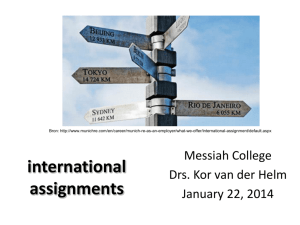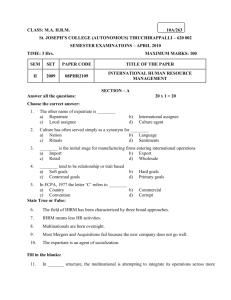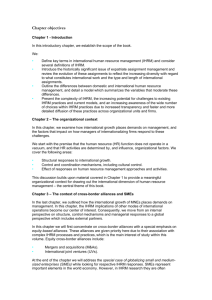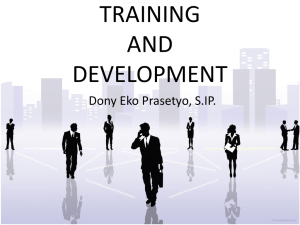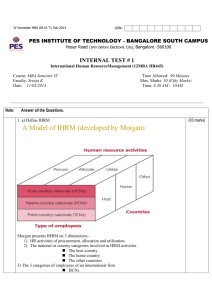Chapter 1 - Introduction
advertisement
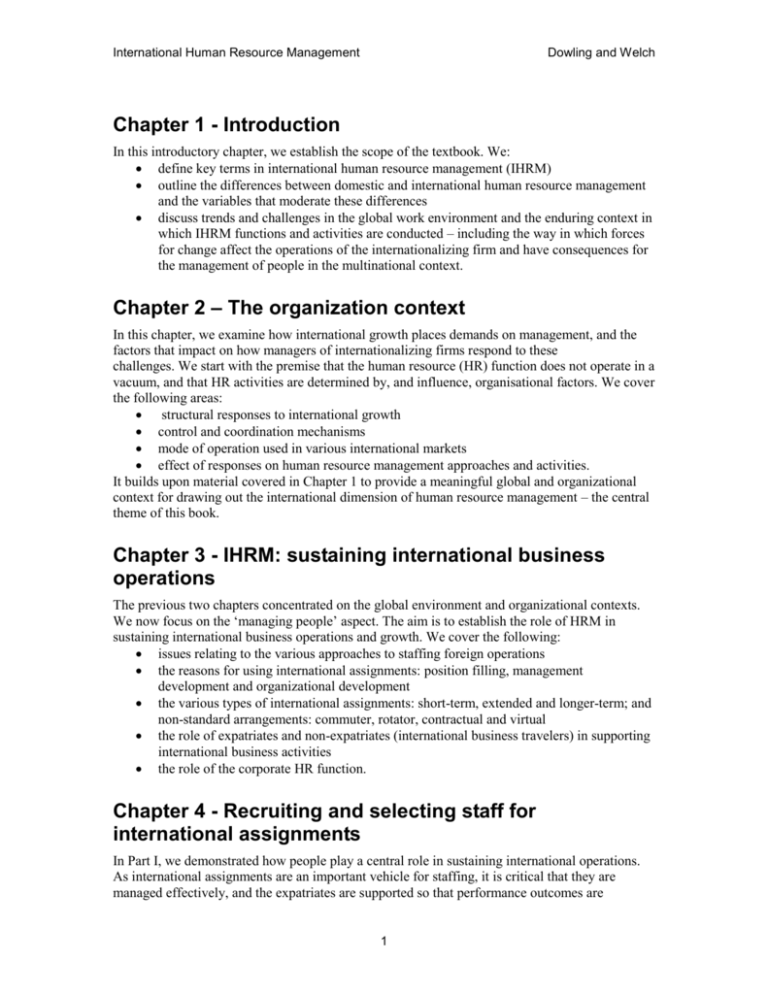
International Human Resource Management Dowling and Welch Chapter 1 - Introduction In this introductory chapter, we establish the scope of the textbook. We: define key terms in international human resource management (IHRM) outline the differences between domestic and international human resource management and the variables that moderate these differences discuss trends and challenges in the global work environment and the enduring context in which IHRM functions and activities are conducted – including the way in which forces for change affect the operations of the internationalizing firm and have consequences for the management of people in the multinational context. Chapter 2 – The organization context In this chapter, we examine how international growth places demands on management, and the factors that impact on how managers of internationalizing firms respond to these challenges. We start with the premise that the human resource (HR) function does not operate in a vacuum, and that HR activities are determined by, and influence, organisational factors. We cover the following areas: structural responses to international growth control and coordination mechanisms mode of operation used in various international markets effect of responses on human resource management approaches and activities. It builds upon material covered in Chapter 1 to provide a meaningful global and organizational context for drawing out the international dimension of human resource management – the central theme of this book. Chapter 3 - IHRM: sustaining international business operations The previous two chapters concentrated on the global environment and organizational contexts. We now focus on the ‘managing people’ aspect. The aim is to establish the role of HRM in sustaining international business operations and growth. We cover the following: issues relating to the various approaches to staffing foreign operations the reasons for using international assignments: position filling, management development and organizational development the various types of international assignments: short-term, extended and longer-term; and non-standard arrangements: commuter, rotator, contractual and virtual the role of expatriates and non-expatriates (international business travelers) in supporting international business activities the role of the corporate HR function. Chapter 4 - Recruiting and selecting staff for international assignments In Part I, we demonstrated how people play a central role in sustaining international operations. As international assignments are an important vehicle for staffing, it is critical that they are managed effectively, and the expatriates are supported so that performance outcomes are 1 International Human Resource Management Dowling and Welch achieved. The focus of this chapter, then, is on recruitment and selection activities in an international context. We will address the following issues: the myth of the global manager the debate surrounding expatriate failure factors moderating intent to stay or leave the international assignment selection criteria for international assignments dual-career couples are female expatriates different? Chapter 5 - Training and development Training aims to improve employees’ current work skills and behavior, whereas development aims to increase abilities in relation to some future position or job. In this chapter, we examine how the international assignment is a vehicle for both training and development, as reflected in the reasons why international assignments continue to play a strategic role in international business operations. The role of training in preparing and supporting personnel on international assignments is also considered. We examine the following issues: The role of training in supporting expatriate adjustment and on-assignment performance. Components of effective pre-departure training programs such as cultural awareness, preliminary visits and language skills. Relocation assistance and training for trainers are also addressed. The effectiveness of pre-departure training. The developmental aspect of international assignments and its relation to international career paths. Training and developing international management teams. Reflecting the general literature on this topic, the focus of the chapter is on the traditional, expatriate assignment. However, where possible, we will draw out training and development aspects relating to short-term assignments, non-standard assignments and international business travelers. Chapter 6 - Compensation In the introductory chapter we described IHR managers as grappling with complex issues. International managers must (1) manage more activities from a broader perspective, (2) be more involved in the lives of their far-flung employees, (3) balance the needs of PCNs, HCNs and TCNs, (4) control exposure to financial and political risks and (5) be increasingly aware of and responsive to host-country and regional influences. All of these issues and concerns are brought out in a discussion of compensation issues. In this chapter we: Examine the complexities that arise when firms move from compensation at the domestic level to compensation in an International context. Detail the key components of an international compensation program. Outline the two main approaches to international compensation and the advantages and disadvantages of each approach. Examine the special problem areas of taxation, valid international living cost data and the problem of managing TCN compensation. Examine the recent developments and global compensation issues. 2 International Human Resource Management Dowling and Welch Chapter 7 - Re-entry and career issues Whereas the preceding chapters concentrated on the management and support of international assignments, this chapter deals with what could be called the post-assignment stage. Re-entry, though, raises issues for both the expatriate and the multinational, some of which may be connected to events that occurred during the international assignment. We treat this stage as part of the international assignment. We examine: the process of re-entry or repatriation job-related issues social factors, including family factors that affect re-entry and work adjustment multinational responses to repatriate concerns return on investment (ROI) and knowledge transfer designing a repatriation programme. Chapter 8 - HRM in the host country context Discussion of international HRM issues generally tends to be biased in the direction of expatriate management, particularly that of parent-country nationals, partly owing to their strategic importance. In this chapter, we attempt to redress the balance by examining HRM issues in subsidiary operations. We cover the following aspects: Factors that influence standardization or adaptation of work practices and the role of HR, including host-country culture and workplace environment, mode of operation, firm size, maturity and international experience and subsidiary mandate. Retaining, developing and retrenching local staff. HR implications of language standardization: HCN selection, training and promotion on the basis of language skills. Monitoring HR practices used by foreign subcontractors. Chapter 9 - Industrial relations The focus of the preceding chapters has been on managing and supporting international assignments, post-assignment and the issues in subsidiary operations. In this chapter we: Discuss key issues in industrial relations and the policies and practices of multinationals. Examine the potential constraints that trade unions may have on multinationals. Outline key concerns for trade unions. Discuss recent trends and issues in the global workforce context. Discuss the formation of regional economic zones such as the European Union. Chapter 10 - Performance management The aim of this chapter is to draw together the relevant literature on performance management in the international context as it relates to IHRM. The focus is on identifying those aspects that require a substantial modification of traditional performance management (especially appraisal criteria and processes) that are imposed by international operations. We specifically address the following aspects: multinational performance management at the global and local level: considering aspects such as non-comparable data, the volatility of the global environment, the effect of distance and level of subsidiary maturity performance management as part of a multinational’s control system 3 International Human Resource Management Dowling and Welch factors associated with expatriate performance, including compensation package, task and role, headquarters’ support, host environment factors and cultural adjustment performance management of expatriates and non-expatriates, and for those on nonstandard assignments such as commuter and virtual issues related to the performance appraisal of international employees. Chapter 11 - IHRM trends and future challenges In this final chapter, we identify and comment on observed trends and future directions regarding: International business ethics and HRM. Mode of operation and IHRM. Ownership issues relating to IHRM requirements of organizations other than the large multinational, such as: – small- and medium-sized firms (SMEs) – family-owned firms – non-government organizations (NGOs). Theoretical developments and research issues in IHRM. 4
